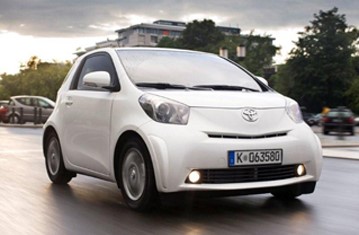Find more information in the General Comments section of the assessment
Find more information in the Rating Validity tab of the assessment
- See More
- See More
- See More
- See More
- Good
- Adequate
- Marginal
- Weak
- Poor
 Passenger
Passenger
 Driver
Driver
 Front Seat
Front Seat
 Car
Car
 Pole
Pole
- Good
- Adequate
- Marginal
- Weak
- Poor


Passenger
outboard
center
Fitted to the vehicle as standard
Not fitted to the test vehicle but available as option
Not Available
In the first side barrier test, part of the ISOFIX attachment broke on the child restraint containing the 3 year infant, although the car's anchorages remained intact. Toyota identified the problem as a change of material by Britax-Römer. Duo Plus child restraints ordered through Toyota dealers will now have an improved material specification. Toyota will contact the owners of all iQs and offer them a replacement restraint if they have already bought a Duo Plus for use in their car. On the basis of this action, Euro NCAP allowed a retest. In that re-test, Toyota's counter-measure proved effective and the child restraint remained properly attached to the ISOFIX anchorages. However, the head of the 3 year old was not contained by the side of the restraint and made contact with the seat of the 1½ year old. Britax-Römer have improved the user's manual and labels of all Duo Plus child restraints to avoid the risk of adverse loading on the ISOFIX attachments as a result of incorrect child seat installation. The passenger airbag can be disabled to allow a rearward facing child restraint to be used in that seating position. However, information provided to the driver regarding the status of the airbag did not meet Euro NCAP's requirements. However, there is a clear warning given of the dangers of using a rearward facing restraint in that position without first disabling the airbag. The presence of ISOFIX anchorages in the rear outboard seats is not clearly marked.
- Good
- Adequate
- Marginal
- Weak
- Poor

Head Impact 11.8 Pts
Pelvis Impact 1.7 Pts
Leg Impact 6.0 Pts
The iQ scored maximum points for the protection offered to pedestrians' legs by the bumper. The bonnet provided mostly good protection in the areas likely to be struck by an adult's head but was predominantly poor for protection of a child's head.
- Good
- Adequate
- Marginal
- Weak
- Poor
| System Name | ESP | |
| Performance | ||
| Applies To | All seats | ||
| Warning | Driver Seat | Front Passenger(s) | Rear Passenger(s) |
| Visual | |||
| Audible | |||
|
|||
Electronic stability control is standard equipment in all European countries. A seatbelt reminder system covering front and rear seats is also fitted as standard.
- Specifications
- Safety Equipment
- Videos
- Rating Validity
Specifications
Tested Model Toyota iQ 1.0, LHD
Body Type - 3 door hatchback
Year Of Publication 2009
Kerb Weight 886kg
VIN From Which Rating Applies - applies to all iQs
Class City and Supermini
Safety Equipment
Note: Other equipment may be available on the vehicle but was not considered in the test year.
Fitted to the vehicle as standard
Fitted to the vehicle as option
Not fitted to the test vehicle but available as option
Not Available
Not Applicable
Videos
Rating Validity


Find more information in the General Comments section of the assessment
 Share
Share










The passenger compartment remained stable during the frontal test. An airbag mounted under the steering wheel provides protection to the driver's knees and femurs. The passenger is restrained from forward movement by an underseat airbag as well by the conventional seatbelt. Both systems worked effectively, readings from the dummies' knees indicating good protection. Toyota showed that a similar level of protection would also be provided to occupants of different sizes and those sat in different positions. The car scored maximum points for protection of the passenger. In the pole test, rib deflections measured by the dummy led to the chest protection being rated as marginal. Marginal protection was provided against whiplash injuries.